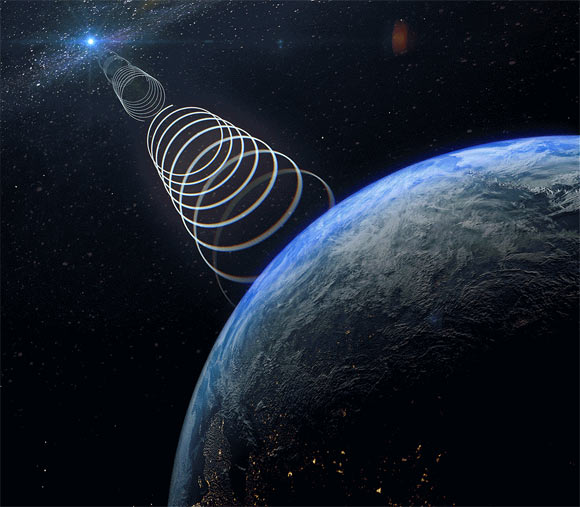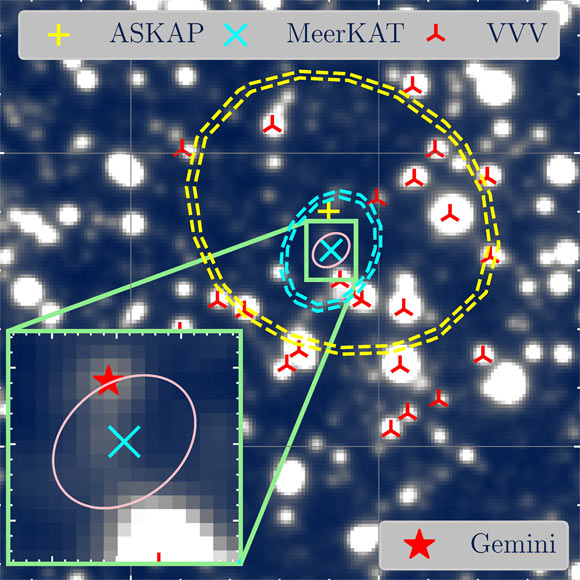Astronomers Find Strange Source of Radio Waves near Milky Way’s Center
Oct 12, 2021 by News Staff
Astronomers using CSIRO’s ASKAP and South African Radio Astronomy Observatory’s MeerKAT radio telescopes have discovered and characterized ASKAP J173608.2-321635, a highly-polarized, highly-variable, steep-spectrum radio source located just 4 degrees from the Milky Way’s center. They’ve largely ruled out most possible origins of this source including stars, normal neutron stars, and X-ray binaries. According to the team, ASKAP J173608.2-321635 may belong to a new class of steep spectrum sources.

An artist’s impression of the ASKAP J173608.2-321635 source. Image credit: Sebastian Zentilomo.
Many types of star emit variable light across the electromagnetic spectrum.
With tremendous advances in radio astronomy, the study of variable or transient objects in radio waves is a huge field of study helping us to reveal the secrets of the Universe.
Pulsars, supernovae, flaring stars and fast radio bursts are all types of astronomical objects whose brightness varies.
“The strangest property of the signal from ASKAP J173608.2-321635 is that it is has a very high polarization,” said Ziteng Wang, a Ph.D. student in the Sydney Institute for Astronomy at the University of Sydney, CSIRO and the ARC Centre of Excellence for Gravitational Wave Discovery (OzGrav).
“This means its light oscillates in only one direction, but that direction rotates with time.”
“The brightness of the object also varies dramatically, by a factor of 100, and the signal switches on and off apparently at random. We’ve never seen anything like it.”
“At first we thought it could be a pulsar or else a type of star that emits huge solar flares,” he added.
“But the signals from this new source don’t match what we expect from these types of celestial objects.”

The Gemini image of ASKAP J173608.2-321635. The yellow contours show the ASKAP detection, while the cyan contours show the MeerKAT detection. The best-fit positions from ASKAP and MeerKAT are shown as yellow + and cyan x, respectively. Inverted Y’s show the sources from the VVV catalog. The small pink contour is the best astrometry constraint from MeerKAT. Image credit: Wang et al., arXiv: 2109.00652.
ASKAP J173608.2-321635 was detected six times between January and September 2020 as part of the Australian Square Kilometre Array Pathfinder Variables and Slow Transients (ASKAP VAST) survey.
The astronomers then monitored the source with the MeerKAT telescope from November 2020 to February 2021 on a 2-4 week cadence.
“We have been surveying the sky with ASKAP to find unusual new objects with a project known as Variables and Slow Transients (VAST), throughout 2020 and 2021,” said Professor Tara Murphy, an astronomer in the Sydney Institute for Astronomy at the University of Sydney and OzGrav.
“Looking towards the center of the Galaxy, we found ASKAP J173608.2-321635, named after its coordinates.”
“This object was unique in that it started out invisible, became bright, faded away and then reappeared. This behavior was extraordinary.”
After detecting six radio signals from the source over nine months in 2020, the astronomers tried to find the object in visual light. They found nothing.
They then turned to the Parkes radio telescope and again failed to detect the source.
“The information we do have has some parallels with another emerging class of mysterious objects known as Galactic Center Radio Transients (GCRTs), including one dubbed the ‘cosmic burper’,” said Professor David Kaplan, an astronomer at the University of Wisconsin-Milwaukee.
“While our new object, ASKAP J173608.2-321635, does share some properties with GCRTs there are also differences. And we don’t really understand those sources, anyway, so this adds to the mystery.”
The team’s paper will be published in the Astrophysical Journal.
_____
Ziteng Wang et al. 2021. Discovery of ASKAP J173608.2-321635 as a Highly-Polarized Transient Point Source with the Australian SKA Pathfinder. ApJ, in press; arXiv: 2109.00652
http://www.sci-news.com/astronomy/radio-source-milky-ways-center-10157.html?utm_source=feedburner&utm_medium=email&utm_campaign=Feed%3A+BreakingScienceNews+%28Breaking+Science+News%29
Thanks to: http://www.sci-news.com
Oct 12, 2021 by News Staff
Astronomers using CSIRO’s ASKAP and South African Radio Astronomy Observatory’s MeerKAT radio telescopes have discovered and characterized ASKAP J173608.2-321635, a highly-polarized, highly-variable, steep-spectrum radio source located just 4 degrees from the Milky Way’s center. They’ve largely ruled out most possible origins of this source including stars, normal neutron stars, and X-ray binaries. According to the team, ASKAP J173608.2-321635 may belong to a new class of steep spectrum sources.

An artist’s impression of the ASKAP J173608.2-321635 source. Image credit: Sebastian Zentilomo.
Many types of star emit variable light across the electromagnetic spectrum.
With tremendous advances in radio astronomy, the study of variable or transient objects in radio waves is a huge field of study helping us to reveal the secrets of the Universe.
Pulsars, supernovae, flaring stars and fast radio bursts are all types of astronomical objects whose brightness varies.
“The strangest property of the signal from ASKAP J173608.2-321635 is that it is has a very high polarization,” said Ziteng Wang, a Ph.D. student in the Sydney Institute for Astronomy at the University of Sydney, CSIRO and the ARC Centre of Excellence for Gravitational Wave Discovery (OzGrav).
“This means its light oscillates in only one direction, but that direction rotates with time.”
“The brightness of the object also varies dramatically, by a factor of 100, and the signal switches on and off apparently at random. We’ve never seen anything like it.”
“At first we thought it could be a pulsar or else a type of star that emits huge solar flares,” he added.
“But the signals from this new source don’t match what we expect from these types of celestial objects.”

The Gemini image of ASKAP J173608.2-321635. The yellow contours show the ASKAP detection, while the cyan contours show the MeerKAT detection. The best-fit positions from ASKAP and MeerKAT are shown as yellow + and cyan x, respectively. Inverted Y’s show the sources from the VVV catalog. The small pink contour is the best astrometry constraint from MeerKAT. Image credit: Wang et al., arXiv: 2109.00652.
ASKAP J173608.2-321635 was detected six times between January and September 2020 as part of the Australian Square Kilometre Array Pathfinder Variables and Slow Transients (ASKAP VAST) survey.
The astronomers then monitored the source with the MeerKAT telescope from November 2020 to February 2021 on a 2-4 week cadence.
“We have been surveying the sky with ASKAP to find unusual new objects with a project known as Variables and Slow Transients (VAST), throughout 2020 and 2021,” said Professor Tara Murphy, an astronomer in the Sydney Institute for Astronomy at the University of Sydney and OzGrav.
“Looking towards the center of the Galaxy, we found ASKAP J173608.2-321635, named after its coordinates.”
“This object was unique in that it started out invisible, became bright, faded away and then reappeared. This behavior was extraordinary.”
After detecting six radio signals from the source over nine months in 2020, the astronomers tried to find the object in visual light. They found nothing.
They then turned to the Parkes radio telescope and again failed to detect the source.
“The information we do have has some parallels with another emerging class of mysterious objects known as Galactic Center Radio Transients (GCRTs), including one dubbed the ‘cosmic burper’,” said Professor David Kaplan, an astronomer at the University of Wisconsin-Milwaukee.
“While our new object, ASKAP J173608.2-321635, does share some properties with GCRTs there are also differences. And we don’t really understand those sources, anyway, so this adds to the mystery.”
The team’s paper will be published in the Astrophysical Journal.
_____
Ziteng Wang et al. 2021. Discovery of ASKAP J173608.2-321635 as a Highly-Polarized Transient Point Source with the Australian SKA Pathfinder. ApJ, in press; arXiv: 2109.00652
http://www.sci-news.com/astronomy/radio-source-milky-ways-center-10157.html?utm_source=feedburner&utm_medium=email&utm_campaign=Feed%3A+BreakingScienceNews+%28Breaking+Science+News%29
Thanks to: http://www.sci-news.com






 Sat Mar 23, 2024 11:33 pm by globalturbo
Sat Mar 23, 2024 11:33 pm by globalturbo

